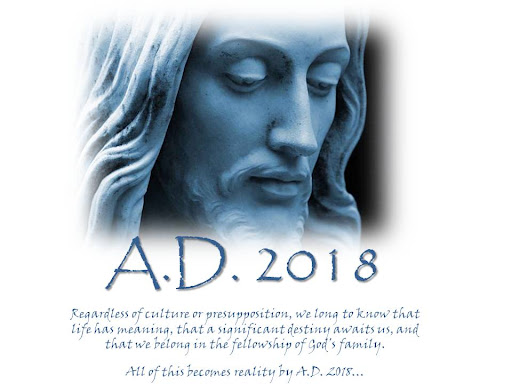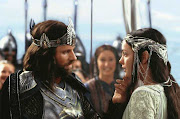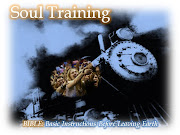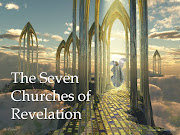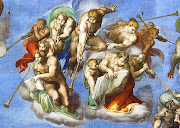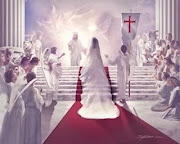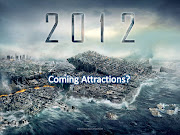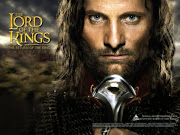Now in the midst of Passover, we're just three days away from celebrating the Lord’s resurrection. That “He is risen”, victorious over sin and the grave, suggests we too can lay claim to this promise, by grace through faith in Christ’s atoning sacrifice. And with two millennia having transpired since Jesus walked among us, the prophetic significance of the (above) passage in Hosea is hard to miss. Taken figuratively, the OT Psalms and the NT epistles suggest a day is as a thousand years with the Lord, which is why many biblical scholars now look for Christ’s second coming in our generation (see Dan Matson's compelling study on this topic).
If so, this world’s need of renewal and outreach has never been greater. With these two imperatives in mind, A.D. 2010 begins this month’s column by revisiting a preview of Mel Gibson’s blockbuster presentation, The Passion of the Christ. As one of the most faithful depictions of Christ’s death, burial and resurrection, we follow this video with an affirmation of God’s end game, as noted in Restoring Paradise Lost. And to add further context to God’s plan of salvation, we also draw parallels between Passover’s historic and prophetic fulfillments in an excerpted study by Jack Kelley.
Then we fast-forward to today with Seeing is Believing, where we revisit the famed Shroud of Turin, an artifact many scientists now believe to be the burial cloth of Christ. And with advances being made in imaging, the Shroud may also allow researchers to reconstruct glimpses of the very face of God. All of which helps us stay mindful of Christianity’s main event, resurrection unto eternal life. Hopefully, these topics provide a framework for your assurance, which is also addressed at the end of the column.
May the power of Christ’s resurrection be yours this year, as we approach the third day…
Maranatha,
Roy J. Tanner
Restoring Paradise Lost
Passover’s Fulfillment
Excerpts of a Bible Study by Jack Kelley
The feasts of Israel have both historical and prophetic fulfillments. Today being Passover we’ll take a look at the world’s oldest continuously celebrated Holy Day from these two perspectives.
When the time came, God called Moses to be the deliverer of the Jewish people and appointed his brother Aaron to help him. After nine judgments had nearly destroyed Egypt, God gave Moses and Aaron instructions to protect them from the 10th and final judgment, the death of the firstborn.
The Historical Fulfillment
“On that same night I will pass through Egypt and strike down every firstborn-both men and animals-and I will bring judgment on all the gods of Egypt. I am the LORD. The blood will be a sign for you on the houses where you are; and when I see the blood, I will pass over you. No destructive plague will touch you when I strike Egypt." (Exod. 12:12-13)
After their hasty meal, around midnight, the destroying angel passed through Egypt and the firstborn of man and animal perished. The angel passed over homes where the doorposts had been painted with lamb’s blood, sparing the people huddled trembling within. They weren’t spared because they were Jewish, nor because they had eaten lamb for dinner. They were spared because they had the faith to paint their doorposts with blood. They were saved by faith through the blood of the lamb.
From that day till this, the Lord’s Passover has been celebrated, one of the most dramatic displays of His power. During the meal they drink four special cups of wine, one each for the four promises God made to Moses from the burning bush. “Therefore, say to the Israelites: ‘I am the LORD , and I will bring you out from under the yoke of the Egyptians.(1. Sanctification) I will free you from being slaves to them (2. Deliverance), and I will redeem you with an outstretched arm and with mighty acts of judgment (3. Redemption). I will take you as my own people, and I will be your God.”(4. Acceptance) (Exod. 6:6-7)
He freed His people from the bonds of slavery, defeating the world’s most powerful country without an army, without a single casualty among His own, by the power of His outstretched arm. Over a million former slaves walked out of Egypt that morning carrying the immense wealth of their former captives, back wages for their hard labor. The sick were healed, the lame walked, and the weak were made strong. Not a single one was left behind.
The Prophetic Fulfillment
In the first chapter of John’s gospel, Jesus was introduced as the Lamb of God, Who takes away the sins of the world. Throughout His ministry people proclaimed Him as Israel’s Messiah, but only on one day did He encourage it. On the Jewish calendar, it was the 10th day of the first month. We know it as Palm Sunday. Throughout Jerusalem Passover lambs were being selected, but on the Mount of Olives the Passover Lamb was being welcomed into the city with shouts of “Hosanna to the Son of David. Blessed is He Who comes in the name of the Lord.” (Matt. 21:9)
From then until the end of the 13th He was minutely scrutinized for some defect in His teaching until finally “no one dared ask Him any more questions.” (Matt 23:46)
After sundown brought the Passover, called Preparation Day in His time, he ate an abbreviated Passover meal with His disciples, stopping at the 3rd cup, the Cup of Redemption. It was a Thursday, the 14th of the month, and before it was over He had been arrested, tried, convicted and put to death by crucifixion. The Passover Lamb had been put to death on Passover. For Christ, our Passover lamb, has been sacrificed, Paul would later say (1 Cor. 5:7).
Just before He died, knowing that all had been completed and so the Scriptures would be fulfilled, He asked for a drink. (John 19:28-29) In taking the wine they offered, He drank the 4th Cup of the Passover, the Cup of Acceptance. “I will take you as my own people, and I will be your God.” From that day forward, anyone who accepted His death as payment for their sins would in turn be accepted into the family of God and receive eternal life. They are saved by faith through the Blood of the Lamb.
The next day would be Friday the 15th, the first Day of the Feast of Unleavened Bread, a special Sabbath where no work could be done (John 19:31). The chief priests asked Pilate to hasten the deaths of the condemned men so they could get them off their crosses before sundown. But Jesus was already dead. He had died at three o’clock and though His body was still on the cross, His spirit was already in Sheol, the abode of the dead. Day one.
At sundown came Friday the 15th, and with it Night One, followed in the morning by Day Two. Saturday the 16th was the regular weekly Sabbath and again no work could be done. It brought Night Two and then Day Three. Another sundown and it was Night three, Sunday the 17th. Three days and three nights, just as He had prophesied. (Matt, 12:40)
At sunrise Sunday morning the 17th, the Feast of First Fruits was being observed at the Temple when the women came to the tomb where He’d been laid to rest. It was their first chance to anoint the body for burial since both Friday and Saturday had been Sabbaths. But the tomb was empty. He had risen, the First Fruits of the First Resurrection.
(The two disciples who met the Lord on the road to Emmaus that Sunday (the day the Lord’s resurrection was discovered) help us to confirm this (Luke 24:13-35). At first they thought the Lord must have been a very recent visitor to the area when He asked them to explain why they were so sad. In the course of the discussion they indicated it was the third day since the crucifixion. “Since” is roughly equivalent to “after”. It being Sunday, the previous day (Saturday) would have been the 2nd day since it happened, and Friday would have been the first day since, making Thursday the day it happened.)
By His death, He freed His people from their slavery to sin, defeating Heaven’s most powerful adversary without an army, without a single casualty among His own, by the power of His sacrificial life. Billions of former slaves will walk out of this world one day soon, receiving wealth beyond measure. The sick will be healed, the lame will walk, and the weak will be made strong. Not a single one will be left behind. The Passover Prophecy was fulfilled.
Shabbat Shalom. May the peace of the Sabbath rest upon you, and may the Grace of our Lord Jesus abide within you, both now and forever more.
http://gracethrufaith.com/selah/holidays-and-holy-days/the-passover-history-and-prophecy/
The Shroud of Turin, a 14-foot cloth in which many believe Jesus Christ was buried, may be the most studied artifact in history—and the most controversial. For centuries, scientists and historians have pored over this bloodstained piece of linen that bears the faint outline of a crucified man, hoping to uncover what the image represents and how it was created.
The first documented reference to the shroud dates back to the 14th century. Historical records suggest it changed hands many times until 1578, when it wound up in its current home—the Cathedral of Saint John the Baptist in Turin, Italy. The Catholic Church has never taken an official position on the cloth’s authenticity, but the Vatican has made statements attesting to its value and arranged for public viewings.
The advent of photography in the late 19th century forever altered the course of the shroud’s history. In 1898, a lawyer named Secondo Pia took the first known photograph of the cloth, and his negative revealed new details—including strikingly clear facial features—that could not be observed with the naked eye. Scientific interest in the relic immediately picked up. In 1902, the French anatomist Yves Delage, an agnostic, inspected the photographs and pronounced that the figure on the shroud was indeed Jesus Christ.
The first direct examinations of the cloth were conducted in the 1970s, most famously by the Shroud of Turin Research Project (STURP), a team of scientists led by physicist John P. Jackson of the University of Colorado. The group found that the markings on the cloth were consistent with a crucified body and that the stains were real human blood; they also suggested that the image’s shading patterns contained three-dimensional information. They could not explain how the imprint ended up on the fabric in the first place.
In 1988, scientists removed a swatch of the shroud for radiocarbon testing. Three independent laboratories concluded that the material originated between 1260 and 1390, leading some to deem it inauthentic. Since then, however, further studies have cast doubt on those results, suggesting that the shroud may indeed date back to the time of Jesus Christ’s life and death.
In March 2010, researchers unveiled a revolutionary radiocarbon dating method that could allow scientists to safely establish accurate ages for precious artifacts like the Shroud of Turin. Unlike traditional carbon dating, the new process does not require samples; instead, the entire object is exposed to an electrically charged gas that gently oxidizes its surface without causing damage. This means that, someday soon, the world may have a more precise estimate of the Shroud of Turin’s real age.
In the spring of 2010, the Shroud of Turin will be available for its first public viewing in 10 years, scheduled from April 10 to May 23.
SHROUD OF TURIN 2010
SON OF GOD – What did Jesus look like? This question has been hotly debated for hundreds of years. During the years 2009 and 2010 the photographer and artist Hans Weishäupl has created a photorealistic image of Jesus. His work is based on the scientific analysis and the original proportions of the shroud of turin, so that the image reflects the results of forensic investigations. In collaboration with Janet Riedel, Weishäupl took photographs of more than 190 individuals from different parts of the world. Taking individual body and facial parts, Weishäupl created the image of an entirely new person, Jesus Christ the way he must have looked like. In order to depict realistc wounds, forensic images of real injuries were used. The famous Shroud of Turin will be shown in an exhibition in the Cathedral of San Giovanni Battista from April 2010 to May 2010.
Don’t Forget The Resurrection
Dr. John MacArthur
What if the resurrection of Jesus Christ were just a first-century myth to be ignored or marginalized as a secondary issue? The implications of that approach are devastating to Christianity.
I want to draw your attention to what Paul wrote in 1 Corinthians 15:16-19 so that you can see what happens when you forget the resurrection.
For if the dead are not raised, not even Christ has been raised; and if Christ has not been raised, your faith is worthless; you are still in your sins. Then those also who have fallen asleep in Christ have perished. If we have hoped in Christ in this life only, we are of all men most to be pitied.
Without question, if Jesus is still in the grave, if He is perpetually the sufferer and never the Victor, then you and I are hopelessly lost. And though that is not the case, I want to focus on the hypothetical "what if" that Paul assumes temporarily in 1 Corinthians 15. "What if the resurrection were a myth? What if Jesus Christ were still dead and in the grave?"
First of all, you would still be in your sins, under the tyranny of death along with the most vile and unbelieving pagan. If Jesus did not rise from the dead, then sin won the victory over Him and continues to be victorious over you too. If Jesus remained in the grave, then, when you die you would also stay dead. Furthermore, since "the wages of sin is death" (Romans 6:23), were you to remain dead, death and eternal punishment would be your future.
The purpose of trusting in Christ is for forgiveness of sins, because it is from sin that we need to be saved. "Christ died for our sins" and "was buried, and ... raised on the third day" (1 Corinthians 15:3-4). If Christ was not raised, His death was in vain, your faith in Him would be pointless, and your sins would still be counted against you with no hope of spiritual life.
Second, if there is no resurrection, then "those also who have fallen asleep in Christ have perished." That means every Old Testament saint, every New Testament saint, and every saint since Paul wrote would be suffering in torment at this very moment. That would include Paul himself, the rest of the apostles, Augustine, Luther, Calvin, Wesley, Moody, and the faithful and prayerful saints you've known--every other believer in every age also would be in hell. Their faith would have been in vain, their sins would not have been forgiven, and their destiny would be damnation.
In light of the other consequences, the last is rather obvious. "If we have hoped in Christ in this life only, we are of all men most to be pitied." Without Christ's resurrection, and the salvation and blessings it brings, Christianity would be pointless and pitiable. Without the resurrection we would have no Savior, no forgiveness, no gospel, no meaningful faith, no life, and we could never have hope for any of those things.
To have hoped in Christ alone in this life would be to teach, preach, suffer, sacrifice, and work entirely for nothing. If Christ is still dead, then He not only has no ability to save you in the future, but He can't help you now either. If He were not alive, where would be your source of peace, joy, or satisfaction now? The Christian life would be a mockery, a charade, a tragic and cruel joke. Christians who suffer and even die for the faith would be just as blind and pathetic as those "believers" who followed Jim Jones and the People's Temple, David Koresh and the Branch Davidians, and Marshall Applewhite and the Heaven's Gate cult.
Since a Christian has no Savior but Christ, no Redeemer but Christ, and no Lord but Christ, if Christ is not raised, He is not alive, and our Christian life is lifeless. We would have nothing to justify our faith, our Bible study, our preaching or witnessing, our service for Him or our worship of Him, and nothing to justify our hope in this life or the next. We would deserve nothing but the compassion reserved for fools.
But, God did raise "Jesus our Lord from the dead, He who was delivered up because of our transgressions, and was raised because of our justification" (Romans 4:24-25). Because Christ lives, we too shall live (John 14:19). "The God of our fathers raised up Jesus, whom you had put to death by hanging Him on a cross. He is the one whom God exalted to His right hand as a Prince and a Savior, to grant repentance to Israel, and forgiveness of sins" (Acts 5:30-31).
We are NOT to be pitied, for Paul immediately ends the dreadful "what if" section by saying, "But now Christ has been raised from the dead, the first fruits of those who are asleep" (1 Corinthians 15:20). As Paul said at the end of his life, "I know whom I have believed and I am convinced that He is able to guard what I have entrusted to Him [i.e. his life] until that day" (2 Timothy 1:12).
Those who do not hope in Christ alone for salvation are the real fools; they are the ones who need to hear your compassionate testimony about the triumph of Christ's resurrection. So don't forget the resurrection; rejoice in it and glory in it, for He is risen indeed.
http://www.gty.org/Resources/Articles/A144
Eternal Security
What We Believe...
Regarding Last Things (Eschatology)
The Rapture of the Church
We affirm the personal, bodily return of our Lord Jesus Christ before the seven-year tribulation (1 Thess. 4:16; Titus 2:13) to translate His church from this earth (John 14:1-3; 1 Cor. 15:51-53; 1 Thess. 4:15-5:11) and, between this event and His glorious return with His saints, to reward believers according to their works (1 Cor. 3:11-15; 2 Cor. 5:10).
The Tribulation Period
We affirm that immediately following the removal of the church from the earth (John 14:1-3; 1 Thess. 4:13-18) the righteous judgments of God will be poured out upon an unbelieving world (Jer. 30:7; Dan. 9:27; 12:1; 2 Thess. 2:7-12; Rev. 16), and that these judgments will be climaxed by the return of Christ in glory to the earth (Matt. 24:27-31; 25:31-46; 2 Thess. 2:7-12). At that time the Old Testament and tribulation saints will be raised and the living will be judged (Dan. 12:2,3; Rev. 20:4-6). This period includes the seventieth week of Daniel's prophecy (Dan. 9:24-27; Matt. 24:15-31; 25:31-46).
The Second Coming and the Millennial Reign
1. After the tribulation period, Christ will come to earth to occupy the throne of David (Matt. 25:31; Luke 1:32,33; Acts 1:10,11; 2:29,30) and establish His messianic kingdom for a thousand years on the earth (Rev. 20:1-7). During this time the resurrected saints will reign with Him over Israel and all the nations of the earth (Ezek. 37:21-28; Dan. 7:17-22; Rev. 19:11-16). This reign will be preceded by the overthrow of the Antichrist and the False Prophet, and by the removal of Satan from the world (Dan. 7:17-27; Rev. 20:1-6).
2. The kingdom itself will be the fulfillment of God's promise to Israel (Is. 65:17-25; Ezek. 37:21-28; Zech. 8:1-17) to restore them to the land which they forfeited through their disobedience (Deut. 28:15-68). The result of their disobedience was that Israel was temporarily set aside (Matt. 21:43; Rom. 11: 1-26) but will again be awakened through repentance to enter into the land of blessing (Jer. 31:31-34; Ezek. 36:22-32; Rom. 11:25-29).
3. This time of our Lord's reign will be characterized by harmony, justice, peace, righteousness, and long life (Is. 11; 65:17-25; Ezek. 36:33-38), and will be brought to an end with the release of Satan (Rev. 20:7).
The Judgment of the Lost
We affirm that following the release of Satan after the thousand year reign of Christ (Rev. 20:7), Satan will deceive the nations of the earth andgather them to battle against the saints and the beloved city, at which time Satan and his army will be devoured by fire from heaven (Rev. 20:9).
1. Following this, Satan will be thrown into the lake of fire and brimstone (Matt. 25:41; Rev. 20:10) whereupon Christ, who is the judge of all men (John 5:22), will resurrect and judge the great and small at the Great White Throne judgment.
2. This resurrection of the unsaved dead to judgment will be a physical resurrection, whereupon receiving their judgment (John 5:28,29), they will be committed to an eternal conscious punishment in the lake of fire (Matt. 25:41; Rev. 20:11-15).
Eternity
We affirm that after the closing of the Millennium, the temporary release of Satan, and the judgment of unbelievers (2 Thess. 1:9; Rev. 20:7-15), the saved will enter the eternal state of glory with God, after which the elements of this earth are to be dissolved (2 Pet. 3:10) and replaced with a new earth wherein only righteousness dwells (Eph. 5:5; Rev. 20:15,21,22). Following this, the heavenly city will come down out of heaven (Rev. 21:2) and will be the dwelling place of the saints, where they will enjoy forever fellowship with God and one another (John 17:3; Rev. 21,22). Our Lord Jesus Christ, having fulfilled His redemptive mission, will then deliver up the kingdom to God the Father (1 Cor. 15:23-28) that in all spheres the triune God may reign forever and ever (1 Cor. 15:28).
